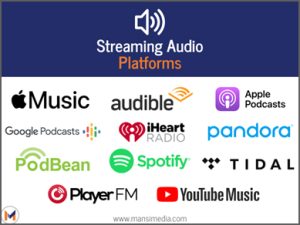Streaming audio advertising in 2023: Five things to know
By Morgan Edge, Digital Media Manager at MANSI Media
The ways in which individuals consume media are rapidly evolving. During the last year, nearly 75% of U.S. internet users, or 222.7 million people, tuned in to digital audio.1 That’s three-quarters of the U.S. population!
You may have noticed that most new cars no longer come with a CD player, or that businesses are opting to play streaming radio stations, like Pandora, at their locations rather than their local FM radio stations. Whether at home, work, the gym, or in their connected cars, listeners are tuning in to audio in more ways than ever. In fact, at-home listening has increased by over 40% since the beginning of the COVID pandemic.2
Advertisers can tap into this audience by running campaigns on popular platforms that allow you to target listeners by interests, hobbies, occupations, and more. In turn, streaming audio offers you a high level of interest and engagement. In fact, audio ads have a 24% higher recall rate than traditional display ads.3
Podcasts are especially effective when it comes to conversions, with 74% of podcast listeners reporting visiting a company or product’s website after hearing an ad.3 Clearly, there is a level of trust already built into digital audio.
Here are five things to know about streaming audio in 2023.
Popular with listeners of all ages
Year after year digital audio continues to gain popularity among millennials and the younger Generation Z as it is a vital aspect of youth culture on the internet. Over 91% of 16- to 24-year-olds listened to digital audio in the first half of 2022 alone.1
Compared to social media, video content and other mediums popular with this demographic, audio reigns as king. In 2022 adults in the U.S. spent more time (1 minute, 40 seconds) each day listening to digital audio than they did watching subscription-based video services (1:27) or using social media networks (1:15).3
If you are looking to connect with younger millennials and Generation Z, streaming audio is a great place to start.
Top audio platforms and mediums

You must understand which platforms and mediums will work best with your customers to connect with an ideal audience via digital audio. The majority of audio listeners opt for a subscription-based platform, with 60% of listeners paying for a streaming audio subscription in 2022.1 Streaming audio companies that focus on subscriptions include Spotify, Pandora, Apple Music/Podcasts, and Audible.
Several of these platforms also offer ad-supported tiers, attracting millions of listeners yearly. Over 270 million listeners on Spotify and 44.2 million listeners on Pandora chose this option in 2022.3 These various platforms allow listeners to tune into their favorite albums, audiobooks and platforms wherever they please.
Devices for streaming audio
Digital audio is not only influenced by demographics and platforms, but also by devices. Whether listeners are tuning in via their smartphones, tablets, computers, smart speakers or connected cars, they are consuming this type of content across devices.
While listening can happen on a wide variety of devices, roughly 80% occurs on mobile.3 This trend has gained quite a lot of speed in the past two years as 2022 marked the first time a majority of the population listened to audio on a smartphone.1
Unlike other forms of media that require undivided attention, streaming audio can occur while listeners are multitasking — driving their cars, cleaning their homes or working out. But don’t be mistaken, this is not passive listening. Over 50% of smart speaker owners are likely to respond to a promotional message they hear on their devices.4
Modernizing audio advertising
Digital audio is modernizing the advertising world. Listeners are heavily influenced by the ads heard on favorite podcasts and platforms that impact large purchasing decisions: a new vehicle, a home entertainment system, and vacations that involve air travel.2 Advertisers can utilize targeted ads, programmatic advertising, and advertising automation to tap into these engaged listeners by sponsoring niche audio content related to their consumers.
In the second quarter of 2022, Spotify’s ad-supported revenue grew by more than 30%, revealing the shift among advertisers toward the digital audio medium.4
Additionally, advertisers who previously relied on broadcast radio can utilize digital audio to reconnect with their lost audience members. Listeners now spend 30% more time with digital audio services than with broadcast radio.4 Smart advertisers know to connect with their audience where and when they are listening.
An essential part of your media mix
Because listeners can tune into audio-based content while going about their daily lives, targeted digital ads are an essential part of any advertiser’s media mix. Digital audio can fill any gaps that may pop up when utilized alongside other forms of digital and traditional advertising.
In the first half of 2022, U.S. internet users spent nearly the same amount of time listening to streaming audio as they did watching broadcast TV daily.1 If an advertiser has already found value in TV advertising, then digital audio is the next step.
Digital audio is here to stay. It can be easily transported across various devices and streamed on several platforms to accommodate the listener’s daily life. Most importantly, it allows advertisers to connect with consumers when and where they are spending time with media.
Digital audio is essential to a modern advertising campaign. Will it be included in your 2023 media mix?
Sources: 1Insider Intelligence; 2Nielsen; 3Basis; 4Spotify
